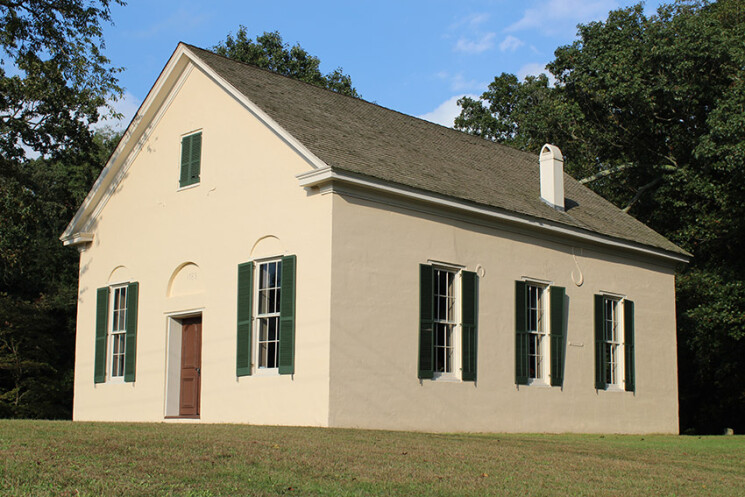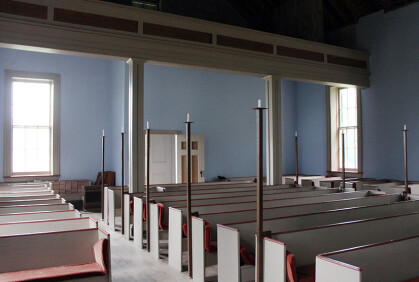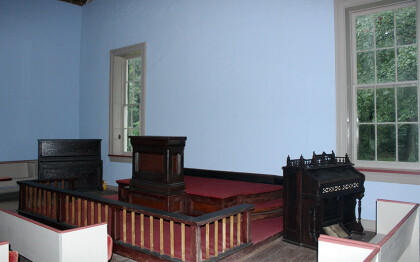Traveling the Circuit: Dudley's Chapel
By Rev. Charles Harrell

Read about other historic Methodist sites that Charles Harrell has
In Queen Anne County on Maryland’s Eastern Shore stands one of the oldest Methodist chapels in America. It was built in 1783
The year 1783 was significant for Methodism and for Maryland. August saw a young man who had only recently purchased his freedom choose the name Richard Allen and receive his papers as a freedman. A fledgling Methodist preacher, the one-day Bishop Allen would rise to become one of Philadelphia’s most prominent
Meanwhile that year, not many miles east of Annapolis, the Methodists built a new chapel.
There is something irresistibly poetic in the history of Dudley’s, as recorded in the Vestry Minutes of 1794, the first year in which parish records were kept:
The house was raised in 1783, covered with cypress shingles in 1784,
In other
Of course, the actual planting of the church was not so easy as the few lines in the minutes suggest. Benjamin Elliott, one of the early laymen at Queen Anne’s Chapel, personally put up the £278, 9s, 2p required to build and furnish the building; he would be years recouping the investment from a relatively poor rural congregation. (The equivalent value today, factoring in changes in labor value, would be close to $400,000.)

Originally a simple brick structure with a whitewashed interior and high pulpit, the chapel had a single-story 20-by-60-foot vestry added onto the rear of the building around 1809; it was used
On the main level, the original bench seating gave way to pews in the 1840's. A stucco finish was applied to the exterior at the time of the chapel’s centennial in 1883, giving Dudley’s the primly elegant external appearance it has today. In the 1990's, steel trusses were installed to add support to the building, by then two centuries old; the cypress-shingle roof was replaced, and core studies of the paint were made to determine the color and composition history of the interior adornment. In the end, the church has been restored to an approximation of its 1883 appearance, including the “Victorian blue” paint in the sanctuary. The effect is simple, yet stately, though sadly some of the interior appointments have had to be removed for safekeeping after a break-in during the 1970's; they are brought out for special occasions only.
Among the prominent Methodist leaders who visited Queen Anne’s Chapel in its early days were Dr. Thomas Coke, Rev. Richard Whatcoat, Rev. Jesse Lee, and Rev. Freeborn Garrettson (the first American-born Methodist preacher). Bishop Francis Asbury is locally remembered as having made annual preaching visits, though his journal is silent on this point. The congregation has also produced a number of clergy over the years.
The years encompassing the Civil War were turbulent ones for Queen Anne’s Chapel, as they were for many churches in the region. In 1853, a group of trustees resigned and moved up the road to found Sudlersville (later Calvary) Methodist Episcopal Church. In
Today, Dudley’s Chapel is a “limited service” facility on the Sudlersville UM Charge, linked with Calvary-Asbury in Sudlersville and St. Paul’s in Ingleside. (Jeffers Chapel UM Church, a predominantly black congregation, meets around the corner from Dudley’s Chapel on Sudlersville Road.) Beginning in 1953, an Easter sunrise service has been held in the building, to which was added a Christmas Eve candlelight service in 1970. In addition to these two services, an annual Homecoming service takes place on the first Sunday in October. All persons are welcome. The chapel also hosts weddings, funerals, baptisms, and other special acts of worship. Groups of school children, reflecting the diversity of Queen Anne County, visit for interpretive history demonstrations. Dudley’s Chapel was listed on the National Register of Historic Places in
Getting to Dudley’s Chapel is easy. Coming from the west, after crossing the Chesapeake Bay Bridge stay on
 Dudley’s Chapel is located at 1110 Benton Corner Road, Sudlersville, Maryland. It is open for visitors on the first Saturday of the month (May - October) from 10:00 a.m. to 2:00 p.m., or by appointment: call (410) 928-3406. Admission is free, with donations gratefully accepted. Mrs. Loretta Walls, the lead volunteer, belongs to a family whose history with Dudley’s goes back
Dudley’s Chapel is located at 1110 Benton Corner Road, Sudlersville, Maryland. It is open for visitors on the first Saturday of the month (May - October) from 10:00 a.m. to 2:00 p.m., or by appointment: call (410) 928-3406. Admission is free, with donations gratefully accepted. Mrs. Loretta Walls, the lead volunteer, belongs to a family whose history with Dudley’s goes back
A stop at Dudley’s Chapel will leave you with additional time during the day to visit other places of interest in the area, such as Centreville or Chestertown (each about 20 minutes
Whether you’re doing a weekend on the Shore or just passing through, take the opportunity to stop by this venerable worship site, reflecting as it does the story both of devotion and division, of faithful beginnings, a painful past, and hope for the future of Methodism in Maryland.
Rev. Charles L. Harrell, Ph.D., is a retired elder in the Baltimore-Washington Conference. When not working at his day job as Director of Pastoral Care for a fabulous area retirement community or teaching in the field of history and doctrine at one of our United Methodist seminaries, he can often be found poking around sites of historical or cultural interest. His not-so-hidden agenda is to incite or fan a similar flame of appreciation for our heritage in faith and its gifts and promise for blessing now and tomorrow.
